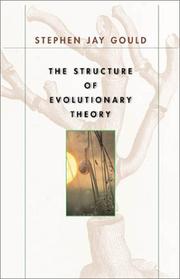| Listing 1 - 2 of 2 |
Sort by
|

ISBN: 0674006135 9780674006133 Year: 2002 Publisher: Cambridge (Mass.) : Belknap press of Harvard university press,
Abstract | Keywords | Export | Availability | Bookmark
 Loading...
Loading...Choose an application
- Reference Manager
- EndNote
- RefWorks (Direct export to RefWorks)
Evolution (Biology) --- Punctuated equilibrium (Evolution) --- Evolution (Biology). --- Punctuated equilibrium (Evolution). --- Evolution. Phylogeny --- 575.8 --- Equilibrium, Punctuated (Evolution) --- Punctuated equilibria (Evolution) --- Punctuationalism (Evolution) --- Animal evolution --- Animals --- Biological evolution --- Darwinism --- Evolutionary biology --- Evolutionary science --- Origin of species --- Biology --- Evolution --- Biological fitness --- Homoplasy --- Natural selection --- Phylogeny --- 575.8 Evolution. Origin of species. Phylogeny --- Evolution. Origin of species. Phylogeny --- Acqui 2006 --- EVOLUTION --- PHILOSOPHY AND SCIENCE --- THEORY

ISBN: 0674417933 0674417925 9780674417922 0674006135 9780674006133 9780674417939 Year: 2002 Publisher: Cambridge, Mass.
Abstract | Keywords | Export | Availability | Bookmark
 Loading...
Loading...Choose an application
- Reference Manager
- EndNote
- RefWorks (Direct export to RefWorks)
The world’s most revered and eloquent interpreter of evolutionary ideas offers here a work of explanatory force unprecedented in our time—a landmark publication, both for its historical sweep and for its scientific vision. With characteristic attention to detail, Stephen Jay Gould first describes the content and discusses the history and origins of the three core commitments of classical Darwinism: that natural selection works on organisms, not genes or species; that it is almost exclusively the mechanism of adaptive evolutionary change; and that these changes are incremental, not drastic. Next, he examines the three critiques that currently challenge this classic Darwinian edifice: that selection operates on multiple levels, from the gene to the group; that evolution proceeds by a variety of mechanisms, not just natural selection; and that causes operating at broader scales, including catastrophes, have figured prominently in the course of evolution. Then, in a stunning tour de force that will likely stimulate discussion and debate for decades, Gould proposes his own system for integrating these classical commitments and contemporary critiques into a new structure of evolutionary thought. In 2001 the Library of Congress named Stephen Jay Gould one of America’s eighty-three Living Legends—people who embody the “quintessentially American ideal of individual creativity, conviction, dedication, and exuberance.” Each of these qualities finds full expression in this peerless work, the likes of which the scientific world has not seen—and may not see again—for well over a century.
Evolution (Biology) --- Punctuated equilibrium (Evolution) --- Equilibrium, Punctuated (Evolution) --- Punctuated equilibria (Evolution) --- Punctuationalism (Evolution) --- Animal evolution --- Animals --- Biological evolution --- Darwinism --- Evolutionary biology --- Evolutionary science --- Origin of species --- Biology --- Evolution --- Biological fitness --- Homoplasy --- Natural selection --- Phylogeny --- adaptation. --- anagenesis. --- competition. --- divergence. --- fossil record. --- genetics. --- germinal. --- hierarchical selection. --- homology. --- inheritance. --- lamarckism. --- mass extinction. --- micro v macroevolution. --- modern synthesis. --- neo darwinism. --- origin of species. --- paleontology. --- punctuated equilibrium. --- speciation. --- variation.
| Listing 1 - 2 of 2 |
Sort by
|

 Search
Search Feedback
Feedback About
About Help
Help News
News